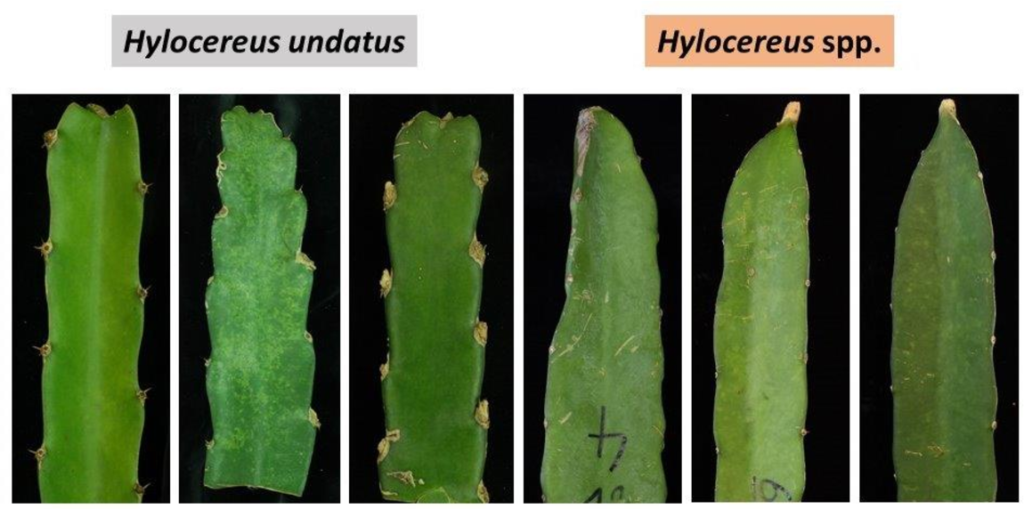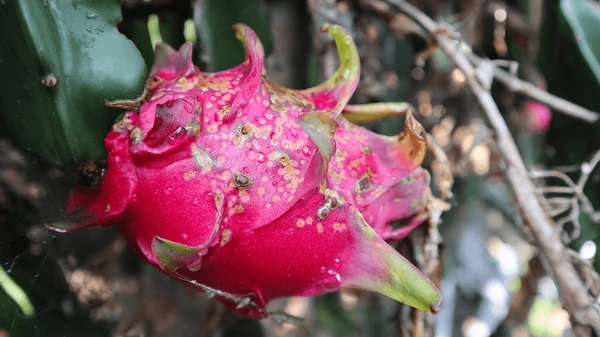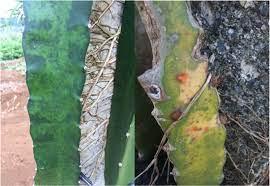This article embarks on a journey to unravel the mysteries of virus-related illnesses in dragon fruit, shedding light on the unseen adversaries that can jeopardise the health of these intriguing cacti. In the lush tapestry of agricultural landscapes, dragon fruit stands as a captivating specimen with its vibrant hues and succulent taste. Yet, beneath the surface of this exotic delicacy lies a tale of intricate biological battles in which viruses play a pivotal role.
Table of Contents

The Genesis of Vulnerability
Dragon fruit, scientifically known as Hylocereus spp., boasts an undeniable allure, but its susceptibility to viral infections is a facet often overlooked. Understanding the genesis of this vulnerability requires delving into the intricate dynamics between the plant and the microscopic assailants.
Viral Onslaught and the Plant’s Defence Mechanisms
Dragon fruit, much like any other botanical entity, employs an array of defence mechanisms to ward off potential threats. However, the adaptability of viruses, with their ability to mutate and outmanoeuvre plant defences, creates an ongoing challenge.
The term virus-related illnesses in dragon fruit encompasses a spectrum of maladies, ranging from mild afflictions to severe, potentially devastating conditions. These viruses infiltrate the plant’s cellular machinery, disrupting essential processes and impeding growth and reproduction.
The Viral illnesses: A Closer Look
1. Dragon Fruit Cactus Virus (DFCV)
One of the primary culprits in the realm of virus-related illnesses in dragon fruit is the Dragon Fruit Cactus Virus (DFCV). This insidious pathogen infiltrates the plant’s vascular system, compromising its ability to transport nutrients efficiently. The consequences manifest as stunted growth, distorted morphology, and a decline in overall vigour.
2. Cactus Necrosis-Associated Virus (CNaV)
Cactus Necrosis-Associated Virus (CNaV) adds another layer to the intricate web of dragon fruit afflictions. This virus induces necrosis, leading to the death of plant tissues. The visible symptoms include darkened spots on the stems and a general deterioration of the plant’s structural integrity.
3. Hylocereus Undatus Necrotic Stunt Virus (HUNSV)
HUNSV, a member of the tombusvirus family, further exemplifies the diversity of viruses affecting dragon fruit. This microscopic adversary induces stunted growth, creating a unique set of challenges for farmers striving to cultivate healthy, productive crops.

Symptoms of virus-related illnesses:
Recognising the symptoms associated with virus-related illnesses in dragon fruit is imperative for early detection and intervention. The manifestations can vary based on the specific virus at play, providing valuable clues to the vigilant observer.
Stunted Growth and Malformation
A hallmark sign of viral intrusion is the stunted growth and malformation exhibited by infected dragon fruit plants. The viruses interfere with the hormonal balance essential for proper development, resulting in abnormal shapes and sizes.
Yellowing and Mottling
The stems and leaves of dragon fruit show signs of disruption from viral infections by turning yellow and mottling. These symptoms often signify a compromise in the plant’s photosynthetic capacity, affecting its ability to generate energy.
Necrosis and Lesions
The appearance of necrotic lesions on dragon fruit plants serves to further highlight the sneaky effects of viruses. These areas of tissue death not only compromise the plant’s structural integrity but also serve as breeding grounds for secondary infections.
The diagnostic processes:
Accurate diagnosis is a pivotal aspect of managing virus-related illnesses in dragon fruit. The complexity lies in the interplay of symptoms, which may overlap or mimic other physiological disorders. Agricultural experts employ a combination of traditional methods and cutting-edge technologies to unravel the viral enigma.
Visual Inspection and Symptom Analysis
A meticulous visual inspection of dragon fruit plants, coupled with a detailed analysis of symptoms, forms the initial diagnostic approach. This hands-on method allows experts to identify patterns and irregularities, providing valuable insights into the potential viral culprit.
Molecular Techniques: PCR and RT-PCR
In the era of technological prowess, molecular techniques like polymerase chain reaction (PCR) and reverse transcription polymerase chain reaction (RT-PCR) have become indispensable tools in the diagnostic arsenal. These techniques enable the identification and characterization of viral genetic material, facilitating a precise diagnosis.

Cultivating Management Strategies
The battle against virus-related illnesses in dragon fruit necessitates a multi-faceted approach, encompassing both preventive measures and targeted interventions. Cultivating resilience in dragon fruit crops involves a synergy of agricultural practices and research-driven strategies.
1. Quarantine and Sanitation Practices
Implementing stringent quarantine measures is paramount to preventing the introduction of infected plant material. Additionally, practicing thorough sanitation in cultivation areas minimises the risk of viral transmission through contaminated tools and equipment.
2. Vector Control Strategies
Viruses often rely on vectors, such as insects, for transmission. Implementing vector control strategies, including the judicious use of insecticides and biological control agents, mitigates the risk of viral spread.
3. Genetic Resistance and Breeding Programmes
The pursuit of resilient dragon fruit varieties through genetic resistance and breeding programmes represents a forward-thinking approach to combating virus-related illnesses. Selective breeding for resistance traits equips plants with the ability to withstand or mitigate the impact of viral infections.
Future Perspectives
As dragon fruit continues to captivate palates worldwide, the spectre of virus-related illnesses casts a shadow over its cultivation. Vigilance and a proactive stance in research and agricultural practices are pivotal to navigating this intricate landscape.
The ongoing quest to understand and combat these viral adversaries holds promise for the future of dragon fruit cultivation. By unravelling the genetic and molecular intricacies of viruses and fortifying plants through innovative breeding programmes, the agricultural community can pave the way for a more resilient and sustainable dragon fruit industry.
Conclusion
The realm of virus-related illnesses in dragon fruit invites us to delve into the microscopic battleground where plants and pathogens engage in an ongoing evolutionary dance. Through knowledge, vigilance, and strategic interventions, we can empower the agricultural landscape to flourish despite the invisible threats that lurk within.
